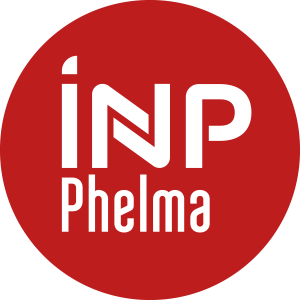Volumes horaires
- CM 10.5
- Projet 0
- TD 10.5
- Stage 0
- TP 0
Crédits ECTS
Crédits ECTS 3.0
Objectif(s)
This course aims at showing how fundamental concepts of the interaction between particles (such as photons, electrons or neutrons) and matter can be used to obtain structural and dynamical information on biological systems with macromolecules, isolated, in complex, or in their cellular context. After a short introduction on the recent approaches and methods in integrated structural biology, Electron Microscopy, X-ray diffraction and scattering, and Nuclear Magnetic Resonance will be developed. The complementarity between these methods to answer complex biological questions will also be addressed. This course will include practical work on advanced instrumentation and hands-on session on world-leading platforms. Students will acquire competences in data acquisition and data processing as well as critical analysis of the results.
Professors : D. Housset, R. Schneider, H. Malet.
Contact Dominique HOUSSET, Helene MALET, Davide BUCCIContenu(s)
More specific aims in Electron Microscopy
Electron microscopy is a method which is currently considered as revolutionary in structural biology as the recent developments of (i) technologies for image collection and (ii) methodologies for image processing allow to determine structures of protein complexes that were previously extremely difficult to obtain. These developments lead to important discoveries on biological targets with fundamental and/or medical relevance. In this part of the course we will learn the composition of an electron microscope and see which central developments were recently done to improve the instrument. We will learn how to prepare a single particle electron microscopy sample (negative stain and cryo-EM) and we will define the different data collection strategies: tomography, random conical tilt, zero-degree tilt. We will then see how to determine a structure using single particle electron microscopy (particle boxing, 2D alignment and classification, 3D reconstruction, resolution determination, model building).
At the end of the module, the student should be able to read and understand the methods, which allow to determine a cryo-EM structure and understand the key biological points deciphered in a structure of a protein complex.
Pre-requisites:
Basic knowledge about proteins (primary, secondary, ternary, quaternary structures)
Basic knowledge about Fourier transforms
More specific aims in Nuclear Magnetic Resonance
Nuclear Magnetic Resonance (NMR) was established in the mid-80s as a powerful alternative method to X-ray crystallography for the structure of bio-macromolecules. Developments in instrumentation to decrease sample needs and increase signal-to-noise ratios, overcome of size-limitations with intelligent data-acquisition schemes in combination with efficient isotopic labeling strategies, and implementation of innovative data processing algorithm, led to significant advances in the extraction of structural and dynamical information on biological systems of increasing complexity. More recently NMR emerged as a key method to study intrinsically disordered biological systems, to offer structural information on low-populated states in conformational exchange with highly populated ground-states, or to yield kinetic and thermodynamic information on macromolecular complexes of low affinity in parallel to structural information. In this part of the course, we will learn basic NMR principles and see which central developments were recently done to improve the instrumentation. We will learn how to manipulate spins through their interaction with oscillating magnetic field in order to recover key information for structure determination and its different steps. We will see how different interactions and their characteristic time-scales can be used to recover dynamic information on protein diffusion in solution, on protein folding and conformational exchange, and on protein shape and local dynamics. Applications of these methodologies to decipher challenging biological questions will be shown along the course.
At the end of the module, the student should be able to perform a critical reading of the NMR structural biology literature, to evaluate the feasibility of a structural determination and the parameters to optimize on a given biomolecular sample, and to interpret dynamical and interaction parameters on biological complex mixtures.
Pre-requisites:
Very basic knowledge in quantum mechanics is advised.
Basic knowledge in protein and nucleic acid structure
More specific aims in X-ray diffraction and scattering
X-ray crystallography has been the first technique used to determine the structure of a protein in the late 50’s. Since these old times and thanks to tremendous developments in X-ray sources, detectors, automation of crystal handling and data processing, X-ray diffraction has become today the main source of macromolecular structural information, contributing almost 90% of the entries deposited in the Protein Data Bank and more than 150000 structures of biomolecules so far. In this part of the course, we will present the basic principles of X-ray scattering and diffraction (also applied to neutrons and electrons), as well as the different methods used to determine the structure of a macromolecule, from the crystallization principles up to data collection, data processing, model building and analysis. Small Angle X-ray Scattering (SAXS) will also be explored, as it provides useful complementary structural information on macromolecules and their complexes in solution. Last, the impact of the latest on-going developments on X-ray sources (X-FEL, next generation of synchrotrons), on our ability to collect data on very small samples and observe very fast (~10 fs) structural changes will be discussed.
At the end of this module, the students should be able to perform a critical reading of articles presenting structural data from X-ray crystallography and SAXS, to point out the different parameters assessing the quality of the structural information and to evaluate whether the described biological outcome is truly supported by structural data.
Pre-requisites:
Basic knowledge about proteins (primary, secondary, ternary, quaternary structures)
Basic knowledge on electromagnetic waves (photons) and their interaction with matter
Basic knowledge about Fourier transforms
Proposal for three review articles that cover concepts detailed in this course
Electron Microscopy:
Elmlund D, Le SN, Elmlund H, “High-resolution cryo-EM: the nuts and bolts” (2017) Current Opinion in Structural Biology, 46, 1-6.
Nuclear Magnetic Resonance:
Marion D, “An introduction to biological NMR spectroscopy” (2013) Molecular and cellular Proteomics, 12, 3006-3025.
Macromolecular X-ray crystallography:
Wlodawer, A., W. Minor, Z. Dauter, and M. Jaskolski (2008) Protein crystallography for non-crystallographers, or how to get the best (but not more) from published macromolecular structures. FEBS J 275: 1–21.
Small Angle X-ray Scattering:
Jacques, D. A., and J. Trewhella (2010) Small-angle scattering for structural biology—Expanding the frontier while avoiding the pitfalls. Protein Sci 19: 642–657.
Assessment
1 written exam (3 H with 1 H for each of the 3 methods discussed in class)
Labwork (limited to 20 Phelma/NSB students)
Description of the labwork
- Electron Microscopy (8 H): sample preparation, principles of data collection, and image analysis
- SAXS (8 H): data acquisition and processing to extract protein size, aggregation and shape
- X-ray crystallography (8 H): data collection on a lab-diffractometer and data processing to extract atomic structure
- NMR (8 H): principles of data collection, analysis of 2D spectra, extraction of structural as well as dynamical parameters
Assessment
1 labwork reporting: 1 report for each of the methods due at the end of the class
Writing advices:
Length of the report: 5 to 10 pages max, including illustrations, for each method
Be concise but highlight the essential and relevant information
Provide a conclusion for each step.
Provide a full legend for each illustration you include in the report.
Please do not copy/paste text from articles! However, you can cite, if you think it is worth it, but in that case, mention that it is a citation and provide the reference.
It is not the number of words that counts, but the reader should feel that you have understood what you have been doing during the practical!
For each of the experiments:
Describe the experimental setup.
Describe the sample preparation and handling.
Describe the experiments that have been carried on and what for.
Describe the data that have been collected.
Describe the main steps of data processing.
Describe the information and key parameters that you have been able to get out of the collected data.
Course documents
Course documents are accessible from INP Chamilo for Phelma students (https://chamilo.grenoble-inp.fr/courses/PHELMA5PMBSBI5/index.php?id_session=0) and from UGA Chamilo for UGA students (https://chamilo.univ-grenoble-alpes.fr/courses/UGA001947/index.php)
Prérequis
- Basic knowledge about proteins (primary, secondary, ternary, quaternary structures)
- Basic knowledge about Fourier transforms
- Very basic knowledge in quantum mechanics is advised
- Basic knowledge in protein and nucleic acid structure
- Basic knowledge about proteins (primary, secondary, ternary, quaternary structures)
- Basic knowledge on electromagnetic waves (photons) and their interaction with matter
Semestre 9 - L'examen existe uniquement en anglais 
SESSION NORMALE :
Types d'évaluation : DS
Evaluation rattrapable : DS
- duree : 3h
- documents autorisés : non
- calculatrices autorisées : oui
- possible en distanciel : non
SESSION DE RATTRAPAGE : DS
Evaluation : DS
- duree : 3h
- documents autorisés : non
- calculatrices autorisées : oui
- possible en distanciel : non
Examen écrit Session 1 : DS1
Examen écrit Session 2 : DS2
N1 = Note finale session 1 = 100% DS1
N2 = Note finale session 2 = 100% DS2
Semestre 9 - Le cours est donné uniquement en anglais 



